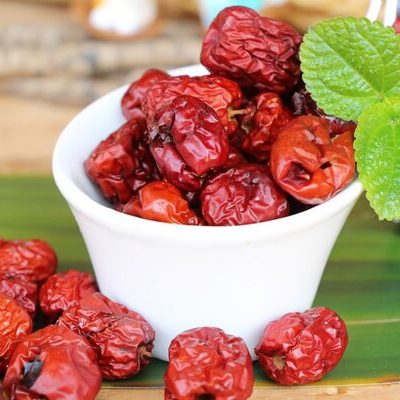
Jujube Fruit
also known as Red Date, Chinese Date
What is Jujube Fruit?
Jujube fruit, also known as red date and Chinese date, is a small and round stone fruit. The ripe fruits are a deep red or purple color. When dried, they have a wrinkled appearance and look like small dates. Jujubes are sweet and have a chewy texture.
- They are a popular delicacy in parts of Asia and are often consumed raw or dried.
- The dried fruits are used in desserts and sweets.
Some common ways to use jujube fruit in the kitchen include:
- Jujube Butter
- Jujube Syrup
- Cordials
- Gummies
- Fermented Jujube Drink
- Chutney
- Soups
- Sugar Substitute
Origin of jujube fruit
Jujubes are believed to be one of the oldest cultivated fruits in the world and can be traced back 7,000 years to the Neolithic age in China. Jujubes fruits are referred to in one of China’s oldest poetry books, The Book of Songs, which dates back to approximately 3,000 years ago. This fruit was used in Traditional Chinese Medicine to promote relaxation and proper sleep. Over time, it traveled to neighboring countries of Southeast and South Asia. Today, it remains an important crop in China, Korea, India, Australia, and Middle Eastern countries.
Nutrition
Jujube fruits are rich in bioactive compounds, such as ascorbic acid, triterpenic acids, phenolic acids, amino acids, saponins, cerebrosides, flavonoids, and polysaccharides. Jujubes also contain vitamins and minerals such as potassium, nitrogen, calcium, phosphorus, iron, manganese, copper, and zinc. These components give the fruit antioxidant, anti-inflammatory, and antimicrobial effects. Jujubes are also known to help prevent cancer, cardiovascular diseases, gastrointestinal diseases, and diabetes.
A 100 g serving contains:

Commercial production
There are currently almost 1,000 different jujube fruit varieties that are commercially grown. Jujubes grow best in climates with hot and dry summers and sufficient rainfall. However, they grow well even under harsh conditions because of their low water requirement and high salt tolerance. It is a great desert plant and is even drought resistant. The tree prefers sandy loamy soils, but also grows well on heavy clay soils.
Fresh jujubes must be consumed within 2-3 days. However, they can last for up to three months, if kept in an airtight container in the fridge. Dried jujubes can be stored for up to one year, if kept in a cool and dry place. Recent studies have found that jujube flour can increase the shelf life of products like sponge cake.
Jujube fruit recipes
This fruit can be used in a variety of sweets and desserts. Here are a few recipes:
- Rice Pudding with Jujube Fruit
- Jujube Ginger Tea
- Sweet And Spice Jujube Bar
- Jujube Paste Stuffing
- Date Nut Bread with Jujube
- Walnut Stuffed Red Dates
- Jujube Butter
- Jujube and Almond Bundt Cake
- Yaksik
- Ber Pickle
- Ba Bao Fan
FDA regulations
The FDA describes all fresh fruits as raw agricultural commodities and strictly regulates all aspects of their growing, harvesting, packing, and storage. However, there are no specific standards of identity for jujube fruits due to their low prevalence in the US. The FDA does strictly regulate the import of jujube fruits into the US.
References
Ahmed K. Rashwan, Naymul Karim, Mohammad Rezaul Islam Shishir, Tao Bao, Yang Lu, Wei Chen, Jujube fruit: A potential nutritious fruit for the development of functional food products, Journal of Functional Foods, Volume 75, 2020, 104205, ISSN 1756-4646, https://doi.org/10.1016/j.jff.2020.104205.
https://www.sciencedirect.com/science/article/pii/S1756464620304291
Jujubes in Western Australia, Department of Primary Industries and Regional Development, Government of Western Australia, https://www.agric.wa.gov.au/minor-fruits/jujubes-western-australia
Liu, M., Wang, J., Wang, L. et al. The historical and current research progress on jujube–a superfruit for the future. Hortic Res 7, 119 (2020). https://doi.org/10.1038/s41438-020-00346-5., https://www.nature.com/articles/s41438-020-00346-5
